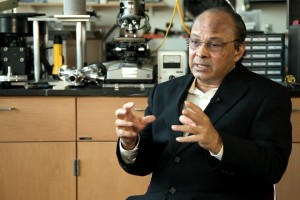Embodied Cognition
Neuroscientist Karl Friston on the place of cognition in our body and outside it, the way we perceive objects,...
Educational neuroscience is an attempt to use new findings about the mechanisms of learning in the brain that are emerging from neuroscience and to understand how they may be translated into implications in the classroom to improve educational outcomes of children. To understand why educational neuroscience is relevant or important, or new, I think, we have to step back a bit and think about what we’re trying to do in the field of psychology.
In psychology we’re basically trying to understand how the mind works, and there’s a bunch of reasons why we might want to do it. We might want to predict how people are going to behave, change, how they’re going to behave in the classroom, we want to understand how to teach children, how to give them skills, how to give them knowledge, how to turn out good citizens for the economy.
So how do we understand how the mind works when all we can see is people’s behavior from the outside? We have to figure out what’s going on inside their minds, and all we can see is behavior. What we do is we use a standard scientific approach: we try and infer hidden calls or entities, mechanisms that we can’t see based on the overt behavior that we see in adults and children. We’ve been pretty good at doing that: we’ve come up with things like working memory, and attention, and perception, and emotions and things like that.
The drawback is that it turns out that as scientists we don’t have very good imagination when it comes to thinking about what might be going on inside people’s heads. We tend to think about the technology of the day and think that it might be a good kind of metaphor for what’s going on inside our head.
You can trace this back through history, you can look at the idea that the mind works like a steam engine (Freudian idea) or that the mind works like a telephone exchange, or that memory works like a hologram. I think, the most recent version of this type of mechanistic metaphor of the mind is the desktop computer: we think that maybe the mind works like a desktop computer. And if you think about the phrase, “working memory”, that’s exactly the same phrase that we use to talk about keeping things in mind and about a computer, that it has working memory. I’m upgrading my computer to 10 gigabytes of working memory. The problem of thinking of the mind in terms of the working of a desktop computer is that’s not really paying attention to how the brain works and what the brain finds easy to do and what it finds hard to do.
This is part of a broader picture: as we are getting a deeper understanding of brain function, we’re beginning to see the influence of neuroscience in multiple different areas, such as understanding of economics or understanding of law, understanding security – these kind of things as a range of wider influences of neuroscience. With rise of understanding of how the brain functions and the emergence of the field of neuroscience we’re beginning to see a wider influence of neuroscience on different areas within society, including how neuroscience impacts on economics, how neuroscience impacts on law.
The other thing that strikes me about teachers, at least in the UK, is that they’re very excited about neuroscience, they’re enthusiastic about it and implicitly that suggests they understand the importance of mechanisms of learning as one aspect of knowledge that should inform their practice. Indeed, they’re so enthusiastic that sometimes they embrace what’s called neuro myths, misconceptions about how the brain works: for instance, that some children are left brain thinkers and some children at right brain thinkers, or that you can’t pay attention in class unless you’re drinking lots of water.
Some people say that this attempt to translate neuroscience in the education can’t be done, that those two disciplines are too far apart, that we’re taking activity of brain cells and looking at the connections between neurons or perhaps we’re using magnetic resonance imaging to see what parts of the brain are more active, and at the other end we’ve got a classroom full of children who are running around and the teachers trying to get them to sit still and learn something. How can those two things match up with each other? Well, certainly the translation between the low level of neuroscience and actual effective techniques that will work in the classroom is a big translation. There are a lot of steps between them about taking new findings from neuroscience and seeing whether they have educational implication. And then seeing, if there is an apparent implication, say, for how many times you might repeat material in certain ways to make sure that it’s best learned, can we actually put that in a form that it’s going to be useful to teachers? But there are people who say that it can’t be done, that really the proper academics, proper scientists that teachers should be talking to are psychologists and not neuroscientists. I think that there are some risks about that approach.
If you ignore how the brain works and you just stick with psychology and these constructs we’ve come up with, particularly those based on the way a computer works, I think that there are things that just make no sense.
Let me give you some examples. So why is it that I’m trying to learn French vocabulary and I forget it a few months or a few years later but I don’t forget that I’m scared of spiders? Why is it that after a good night sleep I seem to be able to remember what I learned yesterday better, why is that? Why is that the teenagers all of a sudden start making risky decisions and trying to impress their friends, what happens then? Why is it that I seem to be able to learn a new language better when I’m five years of age than when I’m 50 years of age? All of these things have no basis in understanding what a computer does. Another example, why is it that I do lots of learning on my topic, I sit in an exam and I’m really stressed and suddenly my mind goes blank? All of these aspects, things like phobias, things like sleep, things like puberty, things like aging, they have no basis in how a computer works: computers don’t get stressed. So there’s a lot of aspects that appear within children’s behavior, children’s learning that we won’t get any insight into unless we understand how the brain is working.
So the goal of education in that framework is to try and see how we can put the right specialized content into the right systems, but also to train the controlling system, the controller, to make sure that the right parts of the system are activated in the right context. And, of course, we have to bear in mind that the brain is the seat of the emotions as well, and it’s important for children in the classroom to have the emotional stability, security and behavioral regulation to be ready to learn in the classroom.
So the big message of educational neuroscience is that it’s early days, the brain is a very complicated thing, education is very diverse in its goals. But as we understand more about brain mechanisms, there are strong hints that we will be able to transfer that into lessons for learning in the classroom.
So some of the areas where educational neurosciences has made its biggest strides is understanding that the brain circuits and the functionality of skills such as learning to read, such as mathematics, such as doing arithmetic are interesting because children raised in an environment without education just wouldn’t learn those brain structures. So we have this extended special environment of exposing children to letters and written forms, and pronunciation, and reading, and the comparison of reading to pictures and scenes and scenarios that gradually cause our brain structures to build parts of the brain that will be specialized for reading words, so there’s a visual word form area in the brain and it has certain properties, and that only comes about by spending weeks and weeks training children in these culturally determined environments. The same goes for mathematics, for understanding how we represent size, how we represent symbolic number and what happens in children with developmental disorders like dyslexia or dyscalculia that may limit their ability to learn those aspects.
A good example of how you might transfer from an understanding of neuroscience to what it might mean in the classroom is the example of learning about science. What’s interesting about science is in many cases scientific knowledge overwrites intuitive knowledge about how the world works. Take a six-years-old boy: he learns in class that the world is round, it’s a sphere, it’s a curve surface, but for all of his six years he’s been running out around and for maybe two years he’s been playing football on the football pitch that doesn’t look curve, that looks flat. So how does that child go about learning that the Earth is a sphere when his everyday experience says it’s flat? Well, one way you might think is you just overwrite that old knowledge and you put in the new scientific knowledge. Neuroscience studied expert scientists: you put them in the brain scanner and see what’s happening in their brain. It turns out that what they’re doing is actively inhibiting their intuitive knowledge and activating their scientific knowledge. What makes them an expert is they’re better at inhibiting irrelevant intuitive knowledge.
That gives us a hint that one of the skills that might help children learn science is helping them with this suppression or inhibition skill. There’s actually a technique that we’re evaluating here at the Сentre for Educational Neuroscience in London where we’re training eight, nine, ten years old children in the area of science, to learn about these counterintuitive ideas in science and to suppress the irrelevant intuitive knowledge. And we believe that this will help them acquire the broader topic of science and it’s a technique we’re currently evaluating.
So one possibility about very intelligent individuals is that they have very good inhibitory control skills, the ability to really shut off intuitive knowledge, everyday knowledge that is not relevant to the very technical fields where they’re becoming experts.

Neuroscientist Karl Friston on the place of cognition in our body and outside it, the way we perceive objects,...

Physicist Srinivas Sridhar on non-invasive methods of monitoring, localizing the source of seizures, and brain...

Psychologist Samuel McClure on neurotransmitters, errors in prediction, and neuromarketing